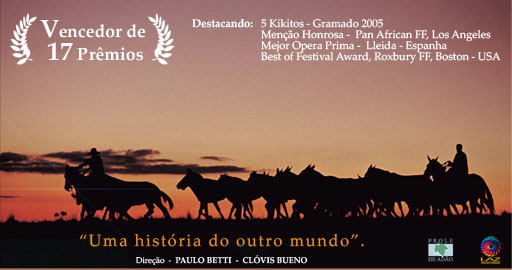Cafundó

Dette her ser ud som en spændende film - en prisbelønnet brasiliansk spillefilm om den historiske person João de Camargo (1858-1942), en soldat og tidligere slave, som skuffelsen over den moderne verden og den undertrykkelse, han som soldat selv skulle deltage i bragte på fortvivlelsens rand.
Her fik han en religiøs oplevelse, som førte ham frem til en syntese mellem de vestafrikanske guder (såkaldte Orixás) og det moderne verdensbillede.
På filmens hjemmeside læser vi om den historiske baggrund:
João de Camargo, born a slave in 1858, was made free in 1888, the slavery abolition year in Brazil, and lived his life as a poor working man. He worked in farms and used to get drunk often. After a vision, in 1906, when several souls appeared to him (a boy called Alfredo, dead in an accident when riding a horse, Saint Benedict, The Virgin Aparecida, and a local Catholic Priest Monsenhor João Soares), he was told about God’s will that he should devote his life to build up a church. At the same time he was given the power of healing and other psychic talents such as clairvoyance, foreseeing the future, and the power of communicating with the souls of the dead, with the saints and God.Gad vide, om den er til at få fat på ...
The worship of João de Camargo has its origin in the practice of the multi-cultured slaves from the Banto group (Angola, Congo and Moçambique) and the Sudanese (Nigeria, Benin, Togo and Gana), the two mainstreams that were the roots throughout Brazil and originated both traditional rituals in Bahia, the so-called "Casas de Candomblé", the "Houses of Candomblé", and in Rio de Janeiro, the "Casas de Umbanda", the "Houses of Umbanda", temples of the major African-Brazilian religious trends. The devotion includes, besides the African elements, a major influence from Catholicism, with a large amount of images of the Saints displayed in his "Capela da Água Vermelha", "Chapel of the Red Water", plus a great influence from spiritism (kardecism) and from the Indian religious practices .
The phenomenon of João de Camargo has been the subject of many social-anthropological studies since 1942 and was pointed out as "the birth of a religion" by the French researcher Roger Bastide in his book "Les Religions Africaines au Brésil" published in 1960.
This present project seeks to rescue the image of this religious leader, known as a "black saint", and to reconstitute his spacetime frame, what means telling the history of the four centuries that were developed during the growth of a traditional Brazilian city, Sorocaba, with its different economical cycles (mining of gold and silver, iron mining, farming, cattle trade, "Bandeirismo", "Tropeirismo" and factories). At the same time, the project brings back relevant facts about the life condition of the black slaves in Brazil and in Angola (both representing the Portuguese settlements in the past), and the specific ways that this religious phenomenon of João de Camargo chose to solve the many conflicts of this cultural combination.
I mellemtiden må vi nøjes med en trailer:
